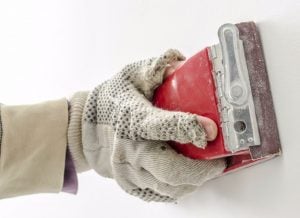[AdSense-A]Odds are if you’re reading this you’re probably somewhere in between hanging drywall and painting the walls. Before adding the finishing touches, you will want to take the time to prep the drywall which is the final step in the drywall process. Hanging the drywall is the difficult part, and with the proper technique, grit of sandpaper and tools, and understanding what not to do, prepping drywall for paint is much easier than you think.
The final process of drywall is sanding. There is more than one way to do this as you can choose to wet sand or dry sand drywall and each process had their pros and cons. For the following, we have taken a closer look at the recommended grit sandpaper for drywall patches, spackle and painted walls as well as some tips and tricks from the pros.
Recommended Grit Sandpaper for Drywall Patches and Spackle
When sanding drywall patches and spackle we fully recommend using a pole sander along with 120 grit sandpaper. Some believe it’s best to start out with a coarser sandpaper, but this isn’t exactly a good idea unless you’re wanting to loose time and put in extra, and unnecessary effort filling in scratches with joint compound.
Using a pole drywall sander, gently sand over the walls being sure being sure to hit all taped seams while utilizing only a mild level of force. In essence, the sander should be doing all the work and exhuming too much force into the sander will inevitably cause divots and other blemishes. After a few passes with 120 grit paper, finishing up with 150 grit paper will give you that desired, smooth finish.
The pole sander is great for sanding drywall and spackle in the center of the walls, but will be difficult to sand in corners. The next step is hand sanding or a hand sander such as an orbital palm sander with 120 to 150 grit sandpaper. For areas in corners with rougher and large amounts of drywall patches and spackle, starting off with 120 and finishing up with 150 grit sandpaper is highly recommended.
Tips for Sanding Drywall Patches and Spackle
Below are some tips from the pros on sanding drywall patches and spackle by hand or with a hand sander:
- Be sure to use an even and consistent amount of pressure and sand in a circular motion to sand out scratches and other blemishes
- Light from a flashlight directly on the wall in the area of patches and spackle will help make seams and other imperfections visible which otherwise would not be seen
- Avoid oversanding which may cause scratches or rip the paper that covers the face of the drywall which will need to be filled in with joint compound
- Use a primer or sealer before painting which will help hide any imperfections such as scratches or other blemishes
Check Out the Top Rated Drywall Sanders
Recommended Grit Sandpaper for Painted Walls
Unfortunately, there are times when you may have to sand the walls after they were just painted. No one wants to have to do something all over again just when they were about finished, but it inevitably happens when you least expect, or want it to happen.
In instances when painted walls have to be sanded for instances when painted dripped onto a wall or when a blemish is noticed after the fact. Sure we could all look the other way, but if you’re a perfectionist like me and want to make sure all your hard-work goes noticed, you’ll want to take the extra time to make it right.
If we’re talking about a small surface area, use 150 grit sandpaper and for obvious reasons, only sand the immediate area. This will help you strip the paint and get to the underlying drywall and/or primer and make the necessary to give you that perfect look you were intending. When finished sanding, you may have to go over with a 180 grit sandpaper before reapplying the paint.
[AdSense-A]





